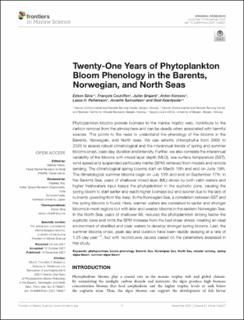| dc.contributor.author | Silva, Edson | |
| dc.contributor.author | Counillon, François | |
| dc.contributor.author | Brajard, Julien | |
| dc.contributor.author | Korosov, Anton | |
| dc.contributor.author | Pettersson, Lasse H | |
| dc.contributor.author | Samuelsen, Annette | |
| dc.contributor.author | Keenlyside, Noel | |
| dc.date.accessioned | 2022-03-29T12:48:31Z | |
| dc.date.available | 2022-03-29T12:48:31Z | |
| dc.date.created | 2021-11-17T10:51:02Z | |
| dc.date.issued | 2021 | |
| dc.identifier.issn | 2296-7745 | |
| dc.identifier.uri | https://hdl.handle.net/11250/2988390 | |
| dc.description.abstract | Phytoplankton blooms provide biomass to the marine trophic web, contribute to the carbon removal from the atmosphere and can be deadly when associated with harmful species. This points to the need to understand the phenology of the blooms in the Barents, Norwegian, and North seas. We use satellite chlorophyll-a from 2000 to 2020 to assess robust climatological and the interannual trends of spring and summer blooms onset, peak day, duration and intensity. Further, we also correlate the interannual variability of the blooms with mixed layer depth (MLD), sea surface temperature (SST), wind speed and suspended particulate matter (SPM) retrieved from models and remote sensing. The climatological spring blooms start on March 10th and end on June 19th. The climatological summer blooms begin on July 13th and end on September 17th. In the Barents Sea, years of shallower mixed layer (ML) driven by both calm waters and higher freshwaters input keeps the phytoplankton in the euphotic zone, causing the spring bloom to start earlier and reach higher biomass but end sooner due to the lack of nutrients upwelling from the deep. In the Norwegian Sea, a correlation between SST and the spring blooms is found. Here, warmer waters are correlated to earlier and stronger blooms in most regions but with later and weaker blooms in the eastern Norwegian Sea. In the North Sea, years of shallower ML reduces the phytoplankton sinking below the euphotic zone and limits the SPM increase from the bed shear stress, creating an ideal environment of stratified and clear waters to develop stronger spring blooms. Last, the summer blooms onset, peak day and duration have been rapidly delaying at a rate of 1.25-day year–1, but with inconclusive causes based on the parameters assessed in this study. | en_US |
| dc.language.iso | eng | en_US |
| dc.publisher | Frontiers | en_US |
| dc.rights | Navngivelse 4.0 Internasjonal | * |
| dc.rights.uri | http://creativecommons.org/licenses/by/4.0/deed.no | * |
| dc.title | Twenty-One Years of Phytoplankton Bloom Phenology in the Barents, Norwegian, and North Seas | en_US |
| dc.type | Journal article | en_US |
| dc.type | Peer reviewed | en_US |
| dc.description.version | publishedVersion | en_US |
| dc.rights.holder | Copyright 2021 The Author(s) | en_US |
| dc.source.articlenumber | 746327 | en_US |
| cristin.ispublished | true | |
| cristin.fulltext | original | |
| cristin.qualitycode | 1 | |
| dc.identifier.doi | 10.3389/fmars.2021.746327 | |
| dc.identifier.cristin | 1955476 | |
| dc.source.journal | Frontiers in Marine Science | en_US |
| dc.relation.project | Trond Mohn stiftelse: BFS2018TMT01 | en_US |
| dc.relation.project | Norges forskningsråd: 276730 | en_US |
| dc.relation.project | Norges forskningsråd: 318085 | en_US |
| dc.relation.project | Norges forskningsråd: 309562 | en_US |
| dc.relation.project | Notur/NorStore: nn9039k | en_US |
| dc.relation.project | Notur/NorStore: NS9039K | en_US |
| dc.identifier.citation | Frontiers in Marine Science. 2021, 8, 746327. | en_US |
| dc.source.volume | 8 | en_US |

